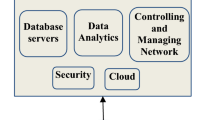Abstract
Due to the development of IT convergence, a wide variety of information is being produced and distributed rapidly in digital form. Lifelog based context awareness is a technology that provides a service automatically based on perceived situational information in ubiquitous environments. To offer customized services to users, the technology of acquiring lifelog based context information in real time is the most important consideration. We propose the interactive middleware architecture for lifelog based context awareness in distributed and ubiquitous environments. Conventional middleware to support ubiquitous environments stores and manages the situational information and service content acquired by centralized storage or a DBMS. Centralized situational information and service content management may impede the autonomy of mobile nodes and the interoperation between different middle software. The proposed method designs a system that can distribute and manage situational information in mobile nodes using mobile devices in distributed and ubiquitous environments and share the service content between interactive middleware through publication. The application system designed in this study was used in a scenario providing situational perception based mobile service and proved to be useful.







Similar content being viewed by others
References
Beamon B, Kumar M (2010) “HyCoRE: towards a generalized hierarchical hybrid context reasoning engine,” In Proc. of the 8th IEEE International Conference Pervasive Computing and Communications Workshops, pp. 30–36
Broll G, Hubmann H, Prezerakos GN, Kapitsaki G, Salsano S (2007) “Modeling context information for realizing simple mobile services,” In Proc. of the 16th IST Mobile & Wireless Communications Summit, pp. 1–5
Choi JH, Kang DH, Jang H, Eom YI (2008) “Adaptive access control scheme utilizing context awareness in pervasive computing environments,” In Proc. of the IEEE International Performance, Computing and Communications Conference, pp. 491–498
Craig A, Davoust A, Esfandiari B (2011) “A distributed Wiki system based on peer-to-peer file sharing principles,” In Proc. of the International Conference Web Intelligence and Intelligent Agent Technology (WI-IAT), pp. 364–371
Gorodetsky V, Karsaev O, Samoylov V, Serebryakov S, Balandin S, Leppanen S, Turunen M (2008) “Virtual P2P environment for testing and evaluation of mobile P2P agents networks,” In Proc. of the International Conference Mobile Ubiquitous Computing, Systems, Services and Technologies, pp. 422–429
Jain P, Dahiya D (2011) Architecture of a library management system using gaia extended for multi agent systems. J Inform Intell 141(7):340–349
Jung YG, Han MS, Chung KY, Lee SJ (2011) A study of a valid frequency range using correlation analysis of throat signal. Information-An International Interdisciplinary Journal 14(11):3791–3799
Kanter T, Pettersson S, Forsstrom S, Kardeby V, Norling R, Walters J, Osterberg P (2009) “Distributed context support for ubiquitous mobile awareness services,” In Proc. of the International Conference Communications and Networking in China, pp. 1–5
Kim JH, Chung KY (2011) “Ontology-based healthcare context information model to implement ubiquitous environment”. Multimedia Tools Appl. doi:10.1007/s11042-011-0919-6
Kim JH, Lee D, Chung KY (2012) Item recommendation based on context-aware model for personalized u-healthcare service. Multimedia Tools Appl. doi:10.1007/s11042-011-0920-0
Liu W, Li X, Huang D (2011) “A survey on context awareness,” In Proc. of the International Conference Computer Science and Service System, pp. 144–147
Ming L (2011) “Ontology-based Context information modeling for smart space,” In Proc. of the IEEE International Conference Cognitive Informatics & Cognitive Computing, pp. 278–283
Mowafi Y, Forgionne G, Zhang D (2010) “Exploring a hybrid approach for modeling context awareness using analytic hierarchy process and simulation,” In Proc. of the International Conference Advances in Human-Oriented and Personalized Mechanisms, Technologies and Services, pp. 46–51
Pawar P, vanBeijnum B-J, Mei H, Hermens H (2009) “Towards proactive context-aware service selection in the geographically distributed remote patient monitoring system,” In Proc. of the 4th International Symposium on Wireless Pervasive Computing, pp. 1–8
Rizou S, Haussermann K, Durr F, Cipriani N, Rothermel K (2010) “A system for distributed context reasoning,” In Proc. of the International ConferenceAutonomic and Autonomous Systems, pp. 84–89
Seyong L, Xiaojuan R, Eigenmann R (2008) “Efficient content search in iShare, a P2P based internet-sharing system,” In Proc. of the IEEE International Symposium Parallel and Distributed, pp. 1–8
Song CW, Chung KY, Jung JJ, Rim KW, Lee JH (2011) Localized approximation method using inertial compensation in WSNs. Information - An International Interdisciplinary Journal 14(11):3591–3600
Sousa JP, Carrpatoso E, Fonseca B (2009) “A service-oriented middleware for composing context aware mobile services,” In Proc. of the International Conference Internet and Web Applications and Services, pp. 357–362
Sousa JP, Schmerl B, Poladian V, Brodsky A (2008) “uDesign: end-user design applied to monitoring and control applications for smart spaces,” In Proc. of the 7th IEEE/IFIP Software Architecture Conference, pp. 71–80
Weiser M (1991) Computer for the twenty-first century, Scientific American, pp. 94–104
Ying L, Weiqin T, Xiaoli Z (2007) “A service reasoning model based on uncertain input parameters,” In Proc. of the International Conference Pervasive Computing and Applications, pp. 154–157
Acknowledgment
This research was supported by Basic Science Research Program through the National Research Foundation of Korea funded by the Ministry of Education, Science and Technology (No. 2012-0004478).
Author information
Authors and Affiliations
Corresponding author
Rights and permissions
About this article
Cite this article
Song, CW., Lee, D., Chung, KY. et al. Interactive middleware architecture for lifelog based context awareness. Multimed Tools Appl 71, 813–826 (2014). https://doi.org/10.1007/s11042-013-1362-7
Published:
Issue Date:
DOI: https://doi.org/10.1007/s11042-013-1362-7




